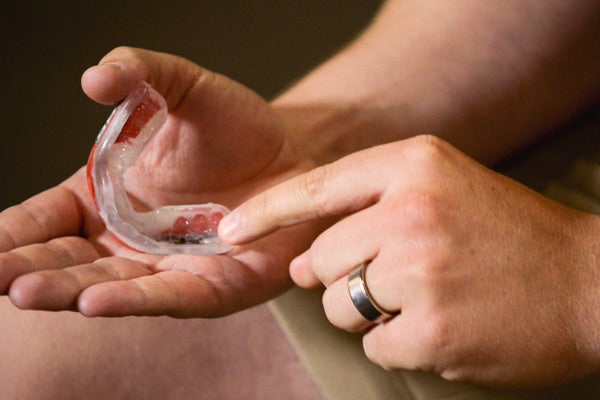|
October 24, 2012
Stanford researchers measure impact of football concussions
Preventing concussions in football requires first knowing what types of hits cause them. Stanford scientists have developed technologies that will help unlock that mystery. By Bjorn Carey

Head athletic trainer Scott Anderson points out the features of the high-tech mouth guard that Stanford football players are wearing this season to gather data on concussions. (Photo: Steve Fyffe / Stanford News Service)
Concussions are arguably football's most prominent injury, but they're also its most mysterious. With the help of the Stanford football team, a group of Stanford doctors and neuroscientists is working to quantify the head trauma that players sustain during a game.
"Here at Stanford we're working as a multi-disciplinary team in order to understand what causes a concussion, what causes these brain injuries," said David Camarillo, an assistant professor of bioengineering at the Stanford School of Medicine.
The research is still in its infancy. The group is establishing the magnitude and types of forces exerted on a player's head and neck when he runs into other bodies over the course of a game or practice. That investigation involves using high-definition, super-slow-motion cameras that track special markings on the helmets to provide details on the impact velocity of a blow to the head.
The researchers have also developed custom mouth guards equipped with accelerometers and gyrometers that measure linear and rotational acceleration – essentially, how violently the head gets whipped around during a game. The data from the sensors, which the scientists pull from the mouth guards after games and practices throughout the season, will provide critical baseline data of how many jarring hits players typically experience. So far, the researchers are finding that helmet-to-helmet impacts aren't the only danger; a crushing shoulder-to-chest hit can toss the head back just as viciously, and players might experience similar forces just from their heads hitting the ground.
"These previous types of head accelerations that maybe weren't counted as hits, maybe they should be counted," said Dr. Daniel Garza, an assistant professor of orthopedic surgery who is affiliated with the Stanford Sports Medicine Center. Garza is also medical director for the San Francisco 49ers of the National Football League.
The data Stanford gathers will be key in creating better protective gear for players, and instituting safety protocols.
"If you really understand carefully what the mechanism of the concussion is, that is where the preventative part comes in, and then we can start zeroing in and prototyping technologies that may reduce the likelihood of sustaining an injury in the first place," Camarillo said.
Football is a good model system for studying head injuries because of the high injury incidence, Camarillo said. However, the group is also studying women's sports, such as soccer, and expects the basic findings to apply to several fields, including military and transportation sectors.
-30-
|